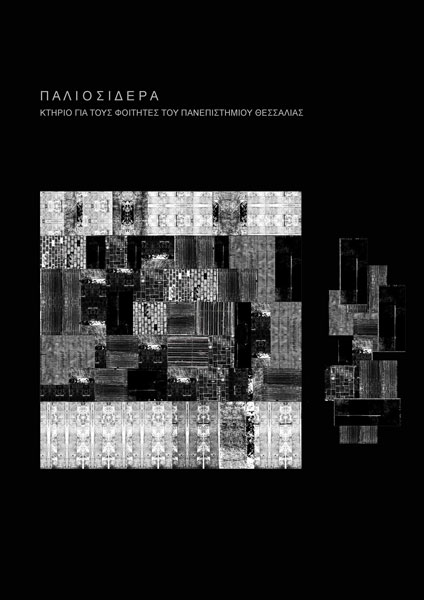

This project is concerned about two main topics: the transformation of the building located at Argonauts, and Borrell streets, in a building with institutional character for students of University of Thessaly. At the same time, a double skin is created with materials that are located at the port and the old city center of Volos. The main idea of this project is the surface-collage.
Supervisor: Manolidis Kostas
Reference Number: 342
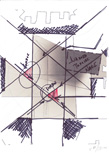

This particular study focuses on the Antigonidon square, a central point to what has always constituted the historical centre of Thessaloniki.
The certain square is characterized by an ambience of average commercial interchange along with high vehicle speeding.
This fallow place, which is in considerable lack of conscious public space, highlights an urgent need for immediate reformation in a way that the square could efficiently integrate the rest of a fluent city.
The fragmentary revelation of the archaic temple neighboring the Antigonidon square along with the incorporation of the gaping spaces of the bordering plots held a fundamental role in the wider concept of the re-designation of the area.
The reintroduction of the feeling of a local neighborhood, the safety of the residents, and the actual benefit of providing these citizens with creative relaxation time and space, constitutes our principal objective.
According to these needs and standards the Antigonidon square is shaped as an urban leisure place. The exposed thematic parks and the wooden mappings that accompany the residents’ routes work to facilitate their movement and lead their way straight to the centre of interaction and socialization, straight to the Antigonidon square.
Supervisor: Stylidis Iordanis
Reference Number: 318


The present final project of architecturewas decided after having read about the case study of the construction of the new football stadium for the greek team Panathinaikos in the district of Votanikos, an area which is located in a very short distance from the centre of Athens, currently abandoned but it used to be an important industrial area in the past. The proposal for the new stadium follows the general replenishment tension of the district, combining a large built volume of sports settlement with extended green areas.
The new pole of recreation and sports has the intention to upgrade the quality of life of the capital’s habitants. At the same time, the necessary public and parking areas are provided to them.
The specifications refer to a fully equipped stadium with the capacity of 44.000 seats in 2 tires and settlements of the youth department of Panathinaikos. Thestadiumcoversasurfaceof60 thousandssqm, from which the 6,8 thousands are the playing field. The building consists of 4 levels; the basement, the ground floor, the first floor with tire and the second tire. Closed rooms are designed for the basement, the ground floor and the first floor in order to host different functions.
During the design of the new stadium of Panathinaikos and the sports settlements, the relation of the construction with the ground was been the centre of importance. The proposal of the design is accompanied by three main principles; the area’s abstinence, the strong position of the stadium to the area and the following of landscape’s lines.
The covert which is the most vivid element of the architectural composition, has a contact with the landscape, while it is based on 52 curved lattices which encircle the playing field. The extension of the lattices’ lines are been maintained to the surrounding area, through the design of the green areas and pedestrian zones.
Supervisor: Triantafillidis Giorgos
Reference Number: 356
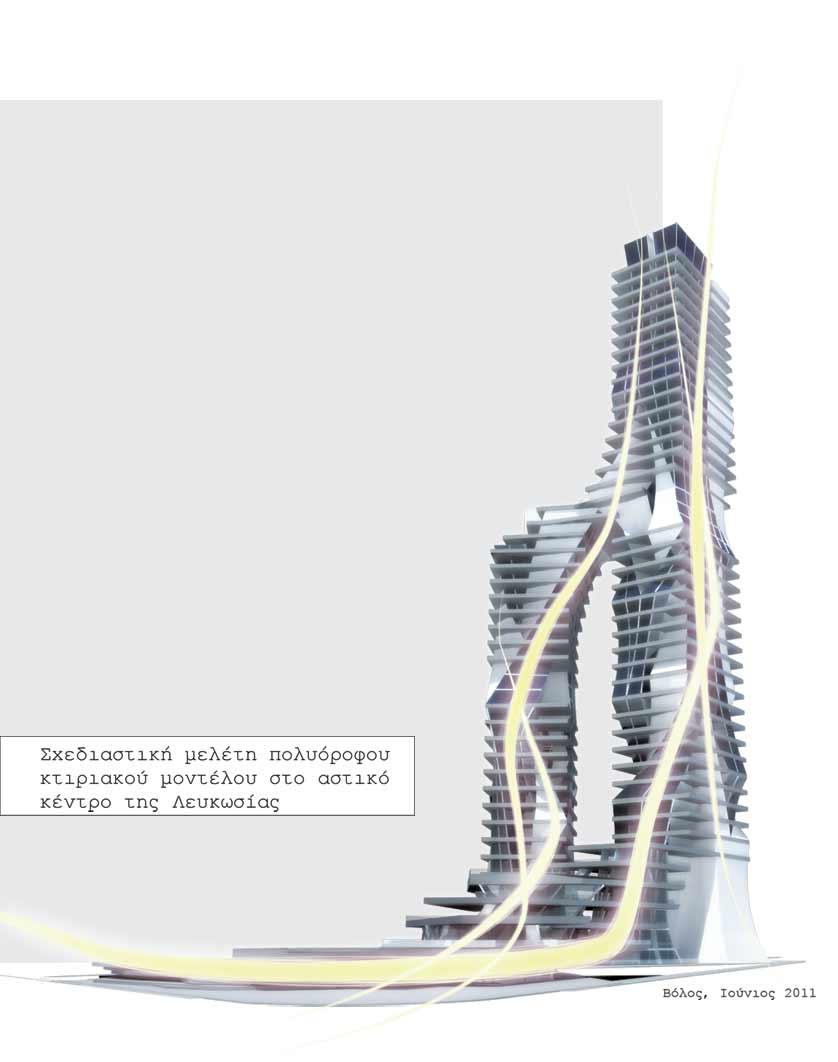

The subject matter of my dissertation work is actually the proposed architectural planning and creation of a mixed-use and highly interactive building which will be rather high for the town of Nicosia.
The theme selection was actually derived from the recent changes over the layout factor , having as a direct implication the entire change of the town planning horizontaline due to height expansion and the resultant life habits and day to day living within the city.
The proposed building is situated in the very center point of Nicosia where the rather historic and full of memories football stadium of G.S.P was located until very recently. The building will host governmental office functions in the range of commercial trading and cultural but it will also compliment private dwelling space enriching thus the whole construction character.
The route to fact finding in relation to the regional character of area and the development of this idea actually target the planning creation of a model building complex that is intended to act as a place of movement , functions and services that will interact with the surrounding environment.
The information gathering about the regional development is eventually resulting into a structure being quite higher than the surrounding buildings.
The model has the advantage of a flexible building management philosophy which will enable the relative regional ease of use, that at the same time will constructively support and sometimes replace.
Finally, the building represent a highlight in terms of building character and ability of use since it will reflect the regional character of the area.
At the same time this building intents to accommodate human daily life cycle in the new high speed and notorious living environment of an ordinary person enjoying the centre of a high character town like Nicosia.
Supervisor: Gavrilou Evelyn
Reference Number: 336
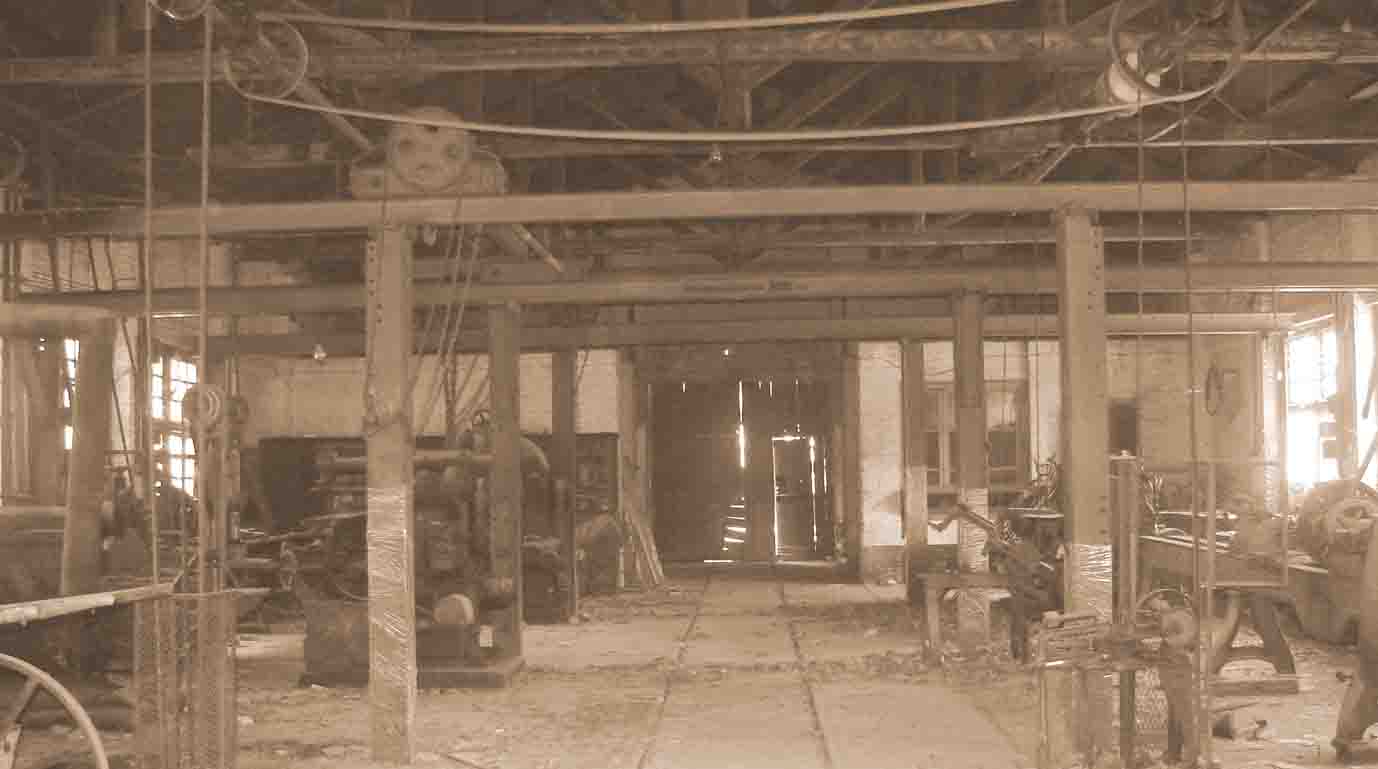

The topic of the diploma thesis is the restoration and the change of use of the existing industrial complex of KOMDE (Vehicle - Machine and Public Construction Center), which is located in the town of Trikala. Since 1963, a construction site has been developed within the buildings of the complex for the drying processes of the lakes in Thessaly. Nowadays, however, it is used as a parking place for the cars of the Prefecture of Trikala. The aim of the paper is the construction of a new university campus that will serve for the accommodation of the town’s two T.E.I s (Technological Educational Institutions). The industrial complex consists of eleven buildings, four of them are reused and they manage to maintain their form, whereas the rest of them are demolished. In addition, a brand new building is created in order to cover the institutions’ needs while at the same time it could be used by the municipality of Trikala. The need to connect all the buildings together led to the construction of exterior corridors and a main entrance made of a mild metal structure. Therefore, the new operational needs are adjusted to the buildings’ typology, maintaining the operational continuity and the area’s historical memory.
Supervisor: Adamakis Kostas
Reference Number: 328
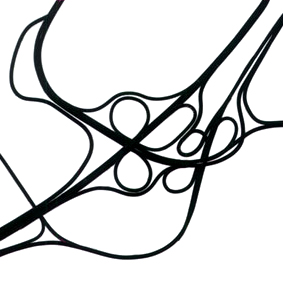

The project is about the interaction that concludes between the building and the line, when the former is set at the edge of the road. On the occasion of the journey, and more specifically the journey by car, this certain operation is placed at the “margin” of the national road network. If we observe it critically, we will see that the national road network integrates with neither the landscape nor the built environment. On the contrary, it is completely distanced and stands in an independent way. At the same time, the growth of speed results to the compression of space, leading to the loss of the sense of space by the driver.
The main purpose of the subject is the highlight, through building interference, of the route as space that entertains the journey. Thereby, on the base of the pre-mentioned critique, we choose to intervene on the old national road network. Due to its structure, the old national road network permits its own use, on the base of the route itself, not according to the two points: the starting point and the destination.
The old national road linking the cities of Athens and Lamia is used as an applied model that can be adjusted on any secondary national network. The buildings designed are supposed to meet many of the needs that occur during the journey, thus they are positioned according to a rhythm which occurs due to these needs. The building is placed in parallel, vertically and over the road.
A central element in the design is the vehicle and its motion inside and around the building. Concluding, the excuse of the journey becomes the motivation for a try-out on the use of the motion and the view as tools for the design.
Supervisor: Paniyiris Costis
Reference Number: 354


This degree thesis deals with the design and the creation of collective housing for elderly people including communal facilities and various services. The housing doesn’t play the role of a clinic or of a residence for elderly people with severe health problems that require intensive and continuous caring from nurseling staff, because it can not provide such services.
The basic idea of the form of the proposed housing originate from the desire for a clear form with outdoor areas in its interior, and the desire for a housing which will be friendly to the elderly people -both in its form and internal organisation as well as in the way of living in it and using it. A residence that will strengthen and encourage its inhabitants to a more collective way of live and towards a more active daily routine, while it will provide them too with a sense of security and a feeling of “neighbourhood”.
The residential building is located in the district of Anavros in the city of Volos between two schools. The building is consisted of four independent linear residential units almost parallel to each other, which are linked with collective spaces that are placed vertical between them in a way to create three large central courtyards and open –air spaces in its interior.
The collective housing is developed around the site with individual building units of different height in each side, so to be avoided as much as possible the shading of the neighboring buildings and also to be achieved the best ventilation and sunlight for its units. This provision of the units, functions as a “natural border” with the surrounding buildings as well as a “filter” of visual protection for the interior of the housing. This provision also provides different vistas to each unit.
The housing contains 26 residential units, which can accommodate maximum 58 people. The residential units are not institutional and aim at senior citizens who seek a more collective way of life. They are designed to satisfy different models of life of elderly people through 3 basic types of housing units, allowing them to choose the degree of independence they would like to have as each wish or need individually. The residential units are autonomous and independent spaces from the rest facilities of the housing complex so its residents can live in them just as they would wish and behave in their "home". Furthermore, the public spaces and the various activities that are available to the them (e.g. choir room, dance, pottery, library, etc.) and the services (e.g. medical care, laundry, etc) that can be provided to the residents can significantly improve their daily lives.
The strengthening of social relationships between the inhabitants of the residences and the encouragement to create new “stronger” relations between them through the use of the collective spaces of the residence and through their cooperation and contribution is an important aim for this design proposal of this thesis. The collective and communal spaces of the housing differentiated and prioritized to “more” and “less” private areas.
Time and motion are important parameters to be able someone to understand this building as a whole, by walking around it and in its interior. It has been given particular emphasis in the design and the organization of the residence, both in the plans and on the facades of the housing, so to become a welcoming social environment not only for its users but also to the rest of neighborhood. Special needs of elderly were taking seriously into account in aim to create a safe environment for them that will provide the maximum freedom and variety of activities
The facades of this building complex are organized in a way to have a clear and district style both on the exterior of the building complex and on its interior. In my intentions, was the final result of the facades of the housing to be contemporary but also to have references in elements of old houses of Volos, either through the use of materials and colors that are familiar to the elderly people (e.g. marble, rock from Pelion, plaster in grey and white color , wood etc), or through the reuse and ‘adjustment” of local/traditional elements, like for example the white frames of the windows. The semi open-air areas of the residential building are designed like small “squares” or “patios” which are especially designed to be accessible to everyone and a pleasant environment.
Supervisor: Manolidis Kostas
Reference Number: 331
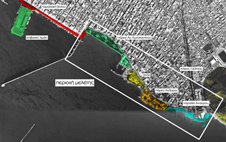

The project attempts the reformation and the unification of Voloʼs waterfront between universitiesʼ central building (Papastratos) and Anavros flow. The purpose is the creiation of a wider, more accessible, discernible, pleasant, united and open public free space with a better connection with the rest coastline and the total urban system.
Supervisors: Trova Vasso, Papadopoulos Lois
Reference Number: 363

